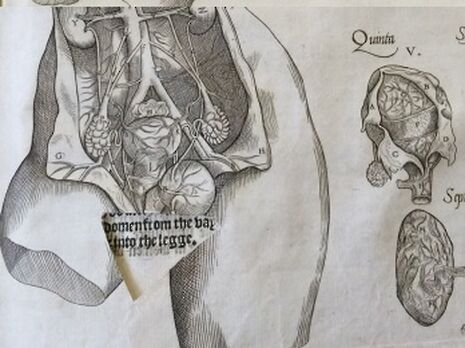John’s book discovery suggests taboo hindered knowledge of female anatomy
A diagram of female genitalia in the 16th-century work was censored, presumably by its original owner

St John's College has acquired a sixteenth-century anatomy book which researchers at the University say indicates that taboo hindered the development of scientific knowledge about the female anatomy.
The edition of Thomas Gemini’s book Compediosa Totius Anatomie Delineatio, dating to 1559, has been subject to much academic attention, as it features an example of censorship by its owner, suggesting that scientific investigation into the female anatomy was hindered by a cultural aversion to female sexuality.
The book depicts a semi-dissected female torso, with a triangle of paper cut away, presumably by the original owner, from where the female genitals would have been. Curator Shelley Hughes suggested that the owner was “disturbed” by “the offending part” of Gemini’s depiction.
"Sin and female flesh were held in close association in 16th century society with naked women often portrayed as the servants of Satan”, Hughes told the Cambridge News.
"Perhaps Christian Europe would have to overcome its shame over the female reproductive organs in order to discover more about their structure."
Her sentiments echo the general purpose of the exhibition - to map the development of medical knowledge as the religious sentiments which impeded human dissection and asserted female biological inferiority gradually faded.
The book was featured in an exhibition named ‘Under the Knife At St John’s: A Medical History Of Disease And Dissection’ on Saturday 25th at St John’s College, which traced medical breakthroughs from as early as the 13th century through pieces from the College Library’s Special Collections
 News / Uni Scout and Guide Club affirms trans inclusion 12 December 2025
News / Uni Scout and Guide Club affirms trans inclusion 12 December 2025 News / Cambridge study finds students learn better with notes than AI13 December 2025
News / Cambridge study finds students learn better with notes than AI13 December 2025 News / Cambridge Vet School gets lifeline year to stay accredited28 November 2025
News / Cambridge Vet School gets lifeline year to stay accredited28 November 2025 Science / Did your ex trip on King’s Parade? The science behind the ‘ick’12 December 2025
Science / Did your ex trip on King’s Parade? The science behind the ‘ick’12 December 2025 News / Pembroke to convert listed office building into accom9 December 2025
News / Pembroke to convert listed office building into accom9 December 2025








